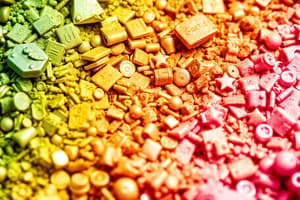Podcast
Questions and Answers
Which property allows metals to be shaped into thin sheets without breaking?
Which property allows metals to be shaped into thin sheets without breaking?
- Malleability (correct)
- Density
- Brittleness
- Ductility
What characteristic makes metals valuable for electronic applications?
What characteristic makes metals valuable for electronic applications?
- Conductivity (correct)
- Flexible nature
- High density
- Brittleness
Which of the following non-metal properties indicates its tendency to crack under stress?
Which of the following non-metal properties indicates its tendency to crack under stress?
- Dull appearance
- Malleability
- Brittleness (correct)
- Lustrous quality
What distinguishes metals from non-metals in terms of appearance?
What distinguishes metals from non-metals in terms of appearance?
How do non-metals generally differ from metals in terms of electrical conductivity?
How do non-metals generally differ from metals in terms of electrical conductivity?
What is a common way metals can be described due to their mass in relation to their volume?
What is a common way metals can be described due to their mass in relation to their volume?
Which statement is true regarding the extraction of metals?
Which statement is true regarding the extraction of metals?
What attribute might confuse students regarding the definition of metals in terms of physical properties?
What attribute might confuse students regarding the definition of metals in terms of physical properties?
Flashcards are hidden until you start studying
Study Notes
Properties of Metals
- Metals possess unique qualities that enhance their utility in various applications.
- Malleable: They can be hammered or rolled into thin sheets without breaking.
- Ductile: Metals are capable of being drawn into wires.
- Lustrous: They exhibit a shiny, reflective surface when polished.
- Dense: Metals have high density, indicating substantial mass relative to their volume.
- Magnetic: Some metals can be magnetized and are attracted to magnets.
Interesting Facts About Metals
- Naturally Occurring: Extracted from the Earth's crust through mining.
- Magnetic Properties: Certain metals, like iron, can be magnetized for diverse applications.
- Durability: High density contributes to metals being heavy and robust.
Properties of Non-Metals
- Flexible: Non-metals can be bent or shaped without breaking.
- Brittle: They are prone to cracking or shattering under stress.
- Dull: Non-metals typically lack a shiny, reflective surface found in metals.
Conductivity
- Metals: Serve as excellent conductors of electricity, crucial for electronic applications.
- Non-Metals: Generally poor conductors of electricity and heat.
Appearance
- Metals: Characterized by a shiny, metallic look.
- Non-Metals: Can display a wide range of colors, from dull to vibrant.
Importance of Understanding Metals and Non-Metals
- Industrial Applications: Essential in construction, transportation, and electronics industries.
- Environmental Impact: Knowledge of properties aids in responsible resource extraction and effective waste management.
Studying That Suits You
Use AI to generate personalized quizzes and flashcards to suit your learning preferences.




